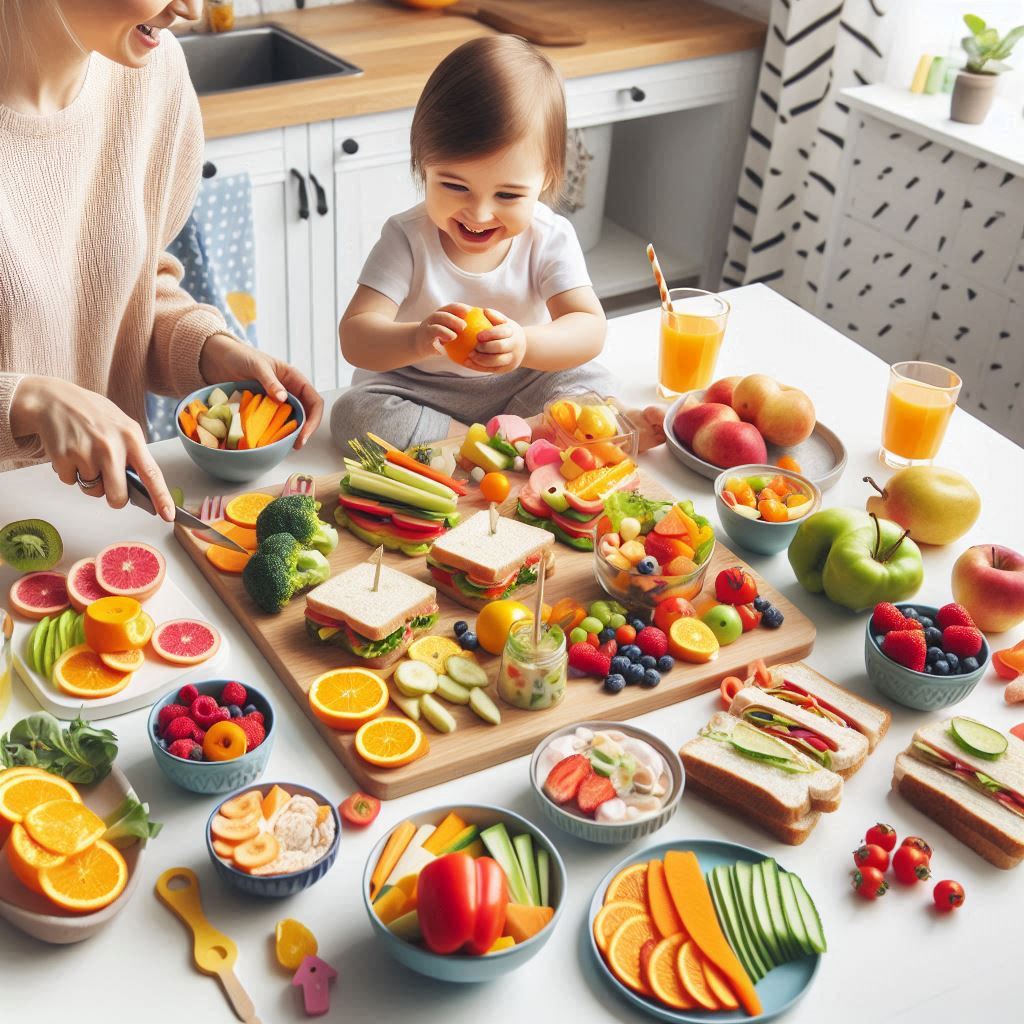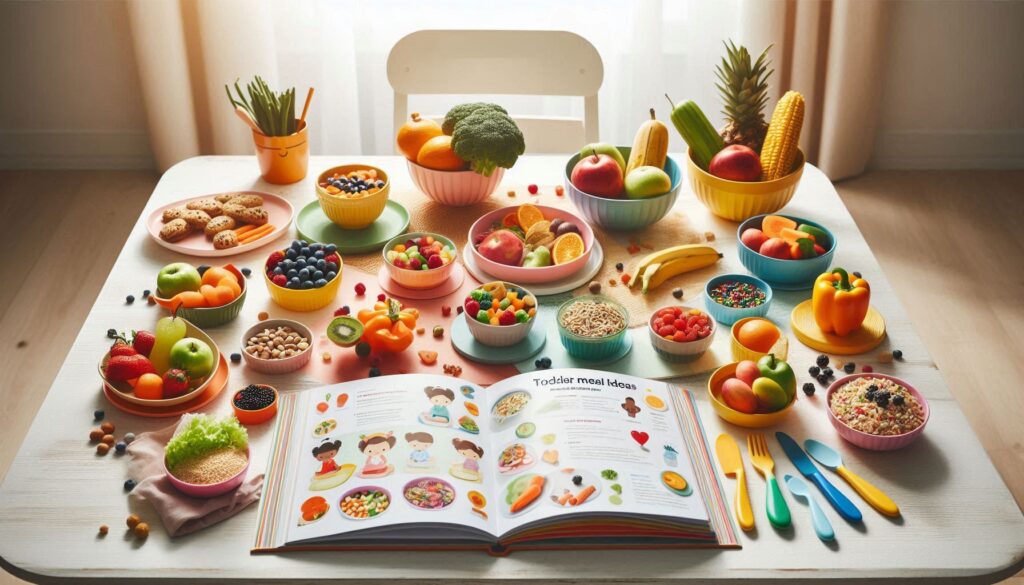Feeding toddlers can feel like navigating a constantly changing maze. One day they love bananas, the next day they’re thrown across the room. As parents, we’re all trying to balance nutrition with reality—creating meals that are healthy but also actually get eaten.
This guide was born from real-life experience with selective eaters, food phases, and those chaotic weeknight dinner rushes. Whether you’re trade with a “yellow-foods-only” point, dealing food allergies, or only looking for quick, healthy choices that don’t want hours in the galley, you’ll find applied keys here.
Our tactic combines truthful meal planning with clever diet hacks (yes, unseen tubers included!) and time-saving training systems. We focus on stable meals that work for busy folks, thoughtful that toddler diet doesn’t need to be Integra-perfect—it just needs to feed growing forms while keeping parent saneness.
From protein-packed breakfasts to freezer-friendly batch cooking, allergen-friendly alternatives to vegetable-focused dishes that even picky eaters will try, this guide offers a flexible framework for feeding your little one through all the toddler phases and challenges.
Winning Over Selective Little Taste Buds
Directing lunchtime with a stubborn two-year-old changed me into a kitchen dick, constantly evolving toddler recipes for picky eaters that wouldn’t end up on the floor! Done uncountable dinner fights, I’ve exposed that hidden veggie recipes are total lifesavers—my son wolfs sweet potato raincoat and cheese without understanding he’s eating tubers. After linking a parents’ cooking set, I learned that touch often stocks more than flavor, so puréed cauliflower in crushed potatoes and finely peeved zucchini in turkey meatballs became our regular healthy meals for picky eaters. The game-changer for our personal was creating “food posts” where my slight one could collect his own mini tacos or own pizzas with pre-selected coatings, generous him control while certifying nutrition. Another sanity-saving line is fixing easy meals for toddlers and adults like sheet pan dinners with distinct units—adults get fully seasoned chicken and roasted vegetables while toddlers can enjoy humbler versions of the same foods. Remember that endurance wins this lengthy; sometimes it takes 15-20 exposures before a toddler accepts a new food, so keep gift range even when those tiny hands impulse the plate gone.

Tailored Nutrition for Growing Explorers
When my daughter turned one, I discovered that recipes for toddlers 12-18 months require a delicate balance between new textures and familiar tastes—soft-cooked vegetable fingers with yogurt dips became our staple, along with mini egg muffins packed with finely chopped spinach that she could grasp with her improving pincer grip. The transition from baby food to table food happens at different paces; my son preferred mashed avocado toast strips while my daughter went straight for small pasta shapes with mild cheese sauce. As children approach two, their independence blossoms along with stronger opinions about food! Creating enticing toddler meal ideas for 2-year-olds means embracing this developmental stage—I found success with “dip stations” featuring hummus, mild salsa, and yogurt alongside colorful vegetable sticks and whole ounce mad. By age two, my children were possessed with “creation” their private food, so collecting simple fruit parfaits or beautifying English muffin pizzas became both an action and a meal. The key change I’ve seen between younger and older toddlers isn’t just about food stability but serving hopes—while my 15-month-old might take two bites of rather new then move on, my 2-year-old needed more large gifts to fuel her endless drive and growing jargon round food likings.
Breakfast Recipes for Toddlers
Fluffy Favorites for Tiny Breakfast Enthusiasts
Morning meals with my toddler transformed when I discovered the magic of banana oat pancakes—three ingredients (mashed ripe bananas, eggs, and rolled oats) blended together create perfectly portable breakfast discs that my little one devours while developing independence. Sunday mornings became less chaotic once I started batch-making toddler waffles with added hemp seeds and a touch of cinnamon, freezing extras between parchment paper for quick weekday reheating. When my son went through his “orange food only” phase, sweet potato pancakes saved our breakfast routine—just mix mashed roasted sweet potato with eggs, a bit of flour, and warming spices for a naturally sweet morning treat that provides lasting energy. For my vegetable-avoiding daughter, spinach pancakes became our secret weapon; the vibrant green color actually attracted her curiosity while the mild flavor (especially when topped with a tiny drizzle of maple syrup) meant she happily consumed leafy greens before 8am. My absolute timesaver hack for busy mornings involves making pancake bites in mini muffin tins—pour any pancake batter into greased cups, add toppings like blueberries or tiny banana slices, and bake at 350°F for about 10 minutes for perfectly portioned finger food that eliminates the need for standing at the stove flipping individual pancakes when you’re already running late.
Protein-Powered Morning Starters
Morning routines got infinitely smoother once I discovered my daughter’s enthusiasm for the humble egg and spinach sandwich – a quick five-minute solution that delivers serious nutrition in a handheld package! The trick I’ve perfected over countless rushed mornings is whisking the eggs with a splash of milk before folding in finely chopped spinach that practically disappears while cooking. For meal-prep magic, my silicone muffin tin has become essential for making broccoli cheese egg bites on Sunday evenings – these protein-packed morsels reheat beautifully and have saved us from drive-thru temptations more times than I can count. When we’re truly racing against the clock, nothing beats a spinach egg wrap using those pre-made whole grain tortillas; I simply spread a thin layer of scrambled eggs mixed with wilted spinach and a sprinkle of cheese before rolling it up burrito-style and securing with parchment paper – perfect for one-handed eating while buckling car seats!
Morning Grain Goodness
Transforming our hectic mornings became possible when I discovered the magic of overnight oats for toddlers, which my five-year-old now helps prepare before bedtime—simply mixing rolled oats with milk, yogurt, and toppings in mason jars creates breakfast that’s ready when we wake! For special weekend mornings, apple cinnamon oatmeal pancakes bring smiles all around; I’ve learned that grating the apple rather than chopping it distributes the flavor evenly while keeping the pancakes from becoming soggy. My ultimate time-saving hack came from batch-cooking banana oatmeal bars on Sunday afternoons—these portable rectangles packed with mashed ripe bananas, whole grain oats, and a sprinkle of mini chocolate chips satisfy hunger during those frantic mornings when we’re running late for preschool drop-off. The nutritionist at my daughter’s pediatric clinic actually requested my recipe after hearing how these fiber-rich morning options helped regulate my formerly picky eater’s digestion while providing steady energy that lasts until lunchtime!
Vegetable-Focused Recipes
Undercover Nutrition Champions

The moment that changed our family dinners forever came when my vegetable-refusing four-year-old gobbled up three servings of pasta covered in spinach pesto without once asking “what’s the green stuff?”—this bright, garlicky sauce hides leafy goodness behind parmesan’s savory appeal! For pasta nights when we need variety, my kale pasta sauce works similar magic by blending the nutrient-dense leaves with roasted tomatoes and sweet bell peppers, creating a sauce so smooth the kids never detect what’s boosting their iron intake. Weekend meal prep always includes a batch of sweet potato veggie patties that freeze beautifully—grated zucchini, carrots, and sweet potatoes bound with chickpea flour create crispy exteriors while maintaining moist centers that even my picky nephew devours with ketchup. On particularly challenging days when vegetables face automatic rejection, my failsafe hidden veggie mac and cheese appears on the table with its creamy sauce secretly packed with pureed cauliflower and butternut squash that perfectly mimic the color and texture of traditional cheese sauce while delivering serious vitamin power!
Perfectly Cooked Plant Power
The dinner expose that distorted my picky diner’s relationship with vegetables ensued when we naked that roasted broccoli and carrots develop an nearly candy-like harmony that charms even the most distrustful little taste shoots! Next myriad failed steamed veggie goes; I’ve found that mixing buds and coins in olive oil with a shake of garlic powder before hot at 425°F creates crispy ends that kids truly request. This broccoli carrot side dish has become our Tuesday night custom, with my daughter now conceitedly helping to place the lively pieces on the boiling sheet. Summer takes an plenty of zucchini for toddlers from our flask garden, which I’ve learned to prepare by slicing into “coins” rather than spears—the smaller circumference cooks more evenly and offers the perfect size for little fingers to grasp. My pediatrician sister-in-law recommends slightly undercooking vegetables for toddlers to maintain nutritional value while ensuring they’re soft enough for developing teeth but firm enough to help strengthen jaw muscles during this crucial growth period.
Simple & Quick Toddler Meals
Effortless One-Vessel Wonders
Motherhood completely transformed how I approach dinner prep, with my trusty slow cooker becoming the unsung hero of our family mealtime strategy! Setting up crockpot chicken alfredo before morning preschool drop-off means returning home to tender chicken and creamy sauce that needs only cooked pasta stirred in during the final minutes—a dinner salvation during those witching-hour meltdowns. My toddler twins particularly love when I make turkey quinoa meatballs in the same device; the gentle, moist cooking method creates perfectly tender spheres that even my texture-sensitive daughter happily devours. For nights when I’ve forgotten to plan ahead, my stovetop Dutch oven creates chicken sausage broccoli pasta in just twenty minutes—I’ve discovered that slicing the pre-cooked sausage thinly and chopping broccoli into tiny florets ensures everything cooks quickly and evenly while remaining manageable for little mouths and developing chewing skills. The pediatric nutritionist at our family practice actually recommended these one-pot approaches not just for their convenience but because the flavors meld beautifully while retaining nutrients that might otherwise be lost in multiple cooking methods!
Make-Ahead Mealtime Saviors
Sunday afternoon batch-cooking sessions transformed our weekday dinner chaos after I discovered the magic of freezer-friendly toddler meals that can be prepared once but enjoyed multiple times! My monthly rotation always includes toddler meatballs (freezable) made with ground turkey, finely minced vegetables, and oats instead of breadcrumbs—these protein powerhouses thaw quickly in the microwave and pair perfectly with pasta or can be stuffed into pita pockets for lunches on-the-go. Breakfast emergencies disappeared once I started making pancake bites (batch-cooked) in mini muffin tins; these silver-dollar sized wonders packed with banana, cinnamon, and tiny blueberries reheat in just 30 seconds and have saved countless morning meltdowns when we’re running late. The game-changing tip my pediatrician sister-in-law shared was to slightly undercook everything destined for the freezer, as the reheating process will finish the cooking without creating dried-out textures that toddlers typically reject. Flash-freezing items on baking sheets before transferring to labeled storage bags prevents frustrating clumping and allows us to grab exactly the portion size needed!
Allergen-Friendly & Special Diets
No-Dairy Delights
When my toddler’s pediatrician definite his dairy feeling, I freaked until learning deep, hearty coconut lentil stew could carry calcium and ease in one ball! This soft, protein-packed bowl uses full-fat coconut milk to create a smooth feel matching any dairy-based paste while red lentils cook down to a perfect spoon able reliability for emerging bothering times. For those certain ticks when coffee passions strike, our family’s rescue comes in the system of vegan 3-ingredient brownies that satisfy all and sundry sweet tooth—the magic blend of ripe mad, cocoa powder, and nut lard creates fudgy cubes that fairly taste better than our earlier butter-laden forms. My sister’s kindergarten class even requested these treats for their allergen-aware classroom parties! The unexpected benefit of our dairy-free journey has been discovering global cuisines that naturally skip milk products while delivering big flavors—my formerly picky eater now happily devours Thai curries, Mediterranean hummus platters, and Japanese rice bowls that keep our meals exciting without requiring separate cooking for different family members.
Wheat-Free Wonders

When my daughter’s celiac finding turned our store upside down, the hunt for toddler-approved gluten-free options became my unforeseen desire project! After myriad galley trials, homemade almond flour crackers emerged as our total game-changer—these brittle, savory bites please her snacking needs while if protein and fit flabs lost in many viable vagaries. The wrong I’ve realized is count a touch of well yeast for a tacky flavor poor of dairy and regular the cash ultra-thin before baking until golden. For breakfast and lunchbox keys, chickpea muffins have progress our regular staple; the sensibly dense bit of chickpea flour creates effortlessly soggy little domes that don’t beat like other gluten-free baked goods. My son, who doesn’t require a gluten-free diet, truly favors these protein-packed treats to even muffins—especially when I fold in blueberries or dark coffee chips! The pediatric nutritionist who helped us steer this trip explicated that meeting on logically gluten-free whole foods pretty than treated locums would better support my spawn’s growth, advice that altered our line from restriction-focused to nutrition-centered
Allergen-Friendly & Special Diets
Muscle-Building Marvels
Navigating my son’s multiple food allergies while ensuring adequate protein intake transformed me from kitchen-phobic to experimental chef, with Greek yogurt pancakes becoming our weekend breakfast revolution! These fluffy circles pack a protein punch that keeps his energy steady until lunch—unlike traditional pancakes that triggered mid-morning meltdowns—and the tangy yogurt creates a tender texture that no one realizes is allergy-friendly. For dinner solutions that satisfy the whole family, quinoa turkey meatballs have become our Tuesday tradition; folding protein-rich quinoa into lean ground turkey creates tender spheres that hold together beautifully even without egg binders. My pediatrician actually recommended this combination after noting my daughter’s growth curve needed support, explaining that complete proteins from both animal and plant sources offer complementary amino acids for optimal development. The unexpected benefit of our allergen-conscious protein journey has been discovering that these nutrient-dense options eliminate the afternoon energy crashes that used to plague our playdate schedule—proving that working around dietary restrictions can actually improve overall nutrition rather than simply substituting problematic ingredients.
Grain-Free Goodness
The turning point in our gluten-free journey arrived not with expensive store-bought substitutes but through kitchen experimentation that led to discovering almond flour crackers that my toddler actually prefers to wheat versions! These delicate, nutty triangles provide satisfying crunch while delivering healthy fats and protein missing in many commercial alternatives – I’ve found adding a pinch of rosemary and sea salt transforms them from simple snacks to sophisticated appetizers adults request at playdates. On busy mornings when traditional breakfast options cause tummy troubles, chickpea muffins have become our family’s salvation – naturally dense and slightly sweet, these golden domes maintain moisture without the crumbly texture that plagues many gluten-free baked goods. My pediatric dietitian cousin explained that both ingredients offer impressive nutritional profiles beyond simply replacing wheat, with chickpea flour providing iron and B vitamins while almond flour delivers vitamin E and magnesium often lacking in restricted diets. The unexpected benefit of our gluten-free adventure has been my formerly picky four-year-old’s newfound willingness to try diverse foods after witnessing our creative kitchen chemistry experiments!
Power-Packed Fuel Options
The morning I naked my son could accept dairy in cultured form changed our lunch routine with Greek yogurt pancakes that send protein without the folk love spine of old styles! These tangy, fleecy discs have developed our stay custom—I’ve achieved the way by addition a bit of vanilla and cinnamon that masks the yogurt’s tartness while keeping its nutritive aids. For feast solutions that fulfill everybody notwithstanding our difficult food needs, quinoa turkey meatballs have transfigured our meal spin; linking the whole protein of quinoa with lean milled turkey creates tender, salt spheres that grip calm prettily even deprived of old-style necessary causes like breadcrumbs or seed. My sister-in-law, a pediatric dietitian, precisely suggested this protein union for my daughter’s evolving needs, light how the amino acid figures stop each other perfectly. The startling benefit of focusing on protein-rich alternatives has been noticing significantly better courtesy during my son’s evening activities—his infant teacher even remarked on his greater ability to stay involved through story time after we attuned his eat choices!
Parent-Friendly Cooking Tips
Revolutionizing our family mealtime strategy started when I discovered adding Greek yogurt to pancake mix creates protein-packed breakfasts that keep toddlers fuller longer—just one cup of plain yogurt per box mix transforms the nutrition profile while creating exceptionally fluffy texture! My Sunday afternoon meal prep for toddlers sessions have become sacred time-savers; I’ve learned that investing two hours chopping, cooking and portioning means grabbing nutritious options becomes easier than processed alternatives during hectic weekday moments. The game-changing technique that converted my vegetable-refusing four-year-old was mastering how to hide veggies in sauces by first roasting them to enhance natural sweetness before blending until completely smooth—cauliflower disappears into mac and cheese while butternut squash perfectly mimics the color and creamy texture of cheese sauce. My pediatrician sister-in-law’s best advice was counterintuitive yet effective: involving children in age-appropriate food preparation creates investment in meals they might otherwise reject, which explains why my daughter now proudly eats her “special green sauce” after helping pick the basil leaves for our weekly pesto batch!
Frequently Asked Questions
My toddler suddenly refuses foods they loved last week. Is this normal?
Absolutely! Food prejudice (fear of new foods) and altering favorites are fully regular changing legs for toddlers. Continue gift rejected foods beside aware favorites without pressure. Sometimes it takes 15-20 foci before a toddler accepts a food, so patience is key. Try offering the same food prepared otherwise—roasted instead of steamed, for example.
How many vegetables should my toddler eat daily?
Rather than focusing on exact quantities, aim for change over volume. The goal is to expose your child to different colors, textures, and flavors over time. Even a tablespoon of vegetables is better than nobody. Try joining tubers into foods they now enjoy—adding spinach to charmers or cross zucchini to meatballs, for case.
What’s the best way to handle picky eating?
Avoid power brawls over food, which can worsen fuss. Instead, follow the partition of duty: you decide what foods to offer and when; your young decides whether and how ample to eat. Bid criticized meals where gears are parted, serve at least one diet you know they’ll eat at all meal, involve them in food training when likely, and model loving a variation of foods physically.
How do I ensure my toddler gets enough protein without dairy?
Plant-based proteins similar lentils, chickpeas, and quinoa are brilliant choices. Coconut milk can offer creaminess in home of dairy. Nut lards (if hates aren’t a concern), tofu, and slim hearts are also right sources. Greek yogurt is often tolerated even by some families with dairy feelings since the culturing process gaps down lactose.
What meals can I prepare ahead for busy weeknights?
Batch culinary is your friend! Fix and freeze mini meatballs, pancakes, muffins, and veggie patties. A vacation hour spent creation some freezer-friendly meals can save you through excited weeknights. Sheet pan dinners with workings that can be parted for toddlers are also resourceful. Instant oats, egg muffins, and slow cooker meals minimize morning and dusk prep time.
How can I include my toddler in meal preparation safely?
Even very early toddlers can help wash capsules and vegetables, tear lettuce, stir hitters (with supervision), shake cheese, and place workings on a plate. By step stools firmly placed away from hot sides allows them to see and participate. Involving children in training rises their notice in tiresome the foods they’ve helped create.
My toddler only wants to eat with their hands. Should I worry?
Self-feeding is an important growing skill and completely appropriate for tots. Offer finger-friendly foods together with utensils without weight. They’ll slowly develop the organization and interest in using gears. Temporarily, focus on the nutritious content slightly than the transfer way. more
Conclusion
The toddler years carry unique nursing trials, but they also offer times to build well foundations for all-time eating ways. The key is litheness and tenacity—kind that toddler diet happens over weeks and months, not meal by teatime.
Evoke that your role isn’t to might definite foods but to unswervingly offer variety in a up, pressure-free environment. Some days will gloss like wins when your young tries roughly new; other days may end with extra food on the floor than in their gut. Both setups are normal parts of this evolving journey.
The formulas and strategies in this monitor are planned to evolve with your child’s moving likings and your clan’s needs. Don’t be afraid to adapt them, joining basics that work for your unique condition. The ultimate goal isn’t excellence but progress—raising offspring who view food as both healthful and fun.
Lastly, be gentle with yourself during this puzzling but rewarding phase. The datum that you’re seeking stable nourishment for your toddler already proves your vow to their health and comfort. Trust that your steady efforts will lastly bear fruit—even if that fruit irregularly gets crushed into the rug along the way.
